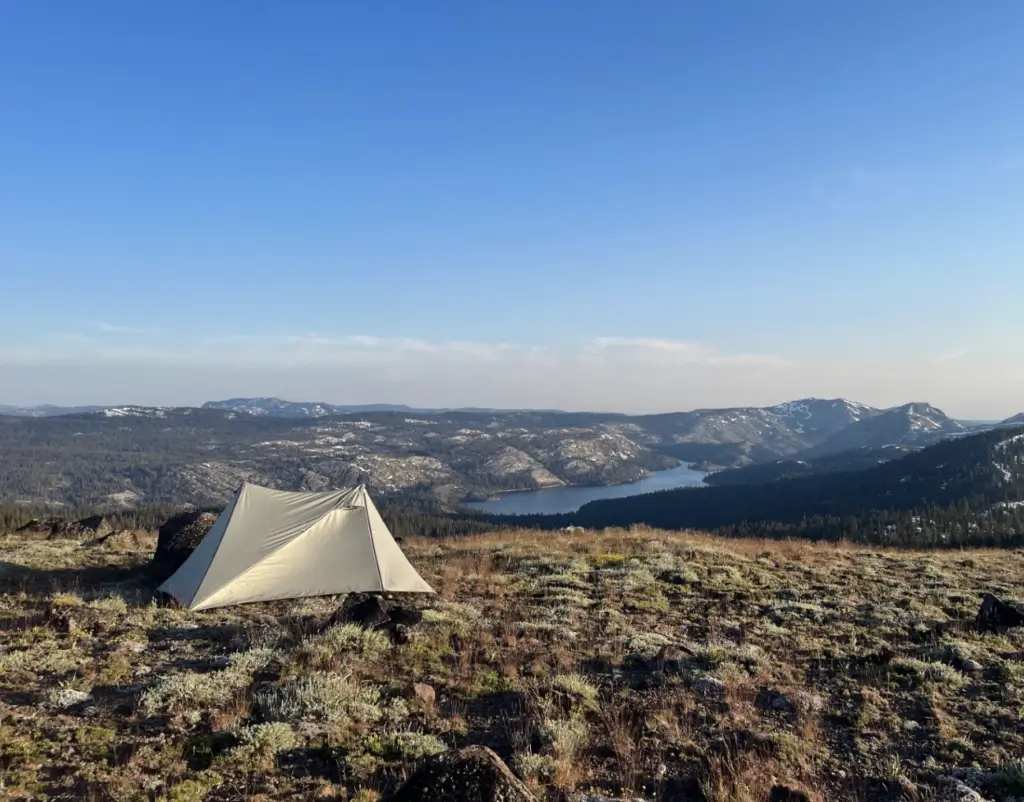Gearing up for Spring and Summer with Peace Outfitters
In Northern Arizona, the turning of the seasons represents not only the prospect of warmer, sunnier weather but also the transition from ski season to camping, hiking, and backpacking season. Here at Peace Outfitters, we understand the excitement that surrounds spring and summer camping and backpacking trips, and we also understand the importance of properly gearing up for these trips. Whether you’re unboxing gear you already own, looking to upgrade your setup, or a new camper making a first-time purchase, let us help you with all your spring and summer gear needs!
Inspecting Your Gear
Ready to pull your camping gear out of storage in preparation for long nights around the campfire or long days on trail? If so, it’s important to inspect your gear before putting it to use again to make sure there are no damages or points of wear and tear. Other than wanting to maintain the longevity of your gear, even small damages could compromise your equipment or place you in a dangerous situation in the front country or backcountry.
Go through your necessary gear item by item, giving it a visual inspection to search for any rips, tears, fraying, splintering, etc. For tents and other shelters, set it up inside your home or in your backyard to ensure that poles, guylines, and footprints are not broken or torn. This will also allow you to more easily check over the material of the tent itself to spot any holes or rips.
Additionally, be sure to check for signs of mold or mildew. If your gear hasn’t been properly cleaned and stored during the off-season or between trips, mold can grow on it which causes material breakdown and deterioration. Common places mold can grow on gear is on inflatable sleeping pads and the inside of tent flys or walls, especially if you use a single-wall shelter.
It’s good to make sure that the gear with which you cook and eat is clean and ready to be used – nothing is more frustrating after a long day of backpacking than finding that your stove is broken. For items in your camp kitchen set up, such as a two-burner stove, pots and pans, or utensils, look for signs of dirt, grease, grime, and mold. Additionally, for your backpacking or car camping stove, it’s especially important to make sure that the burners are mess-free and that the rings and bowls are free of any fluids or food debris.
See a potential issue with your gear but unsure if it’s a problem or not? Bring it on into Peace Outfitters! Our staff is happy to help you look it over. We can help you restring tent poles, replace straps and buckles, or find you replacement gear if it’s beyond repair.
Cleaning Your Gear
Tents and Shelters
If your tent is in needing of a cleaning, it’s crucial to clean it in the right way and with the right supplies so as not to damage it. Follow this process to get it clean:
- Spot clean extra dirty areas with water and a small amount of soap.
- Fill a sink or a bathtub with lukewarm to warm water and put your tent in to soak and submerge it.
- Add a gear-specific cleaning agent, such as Nikwax Tech Wash, to the tub. Follow the instructions on the bottle/container to see how much you should add.
- Submerge your tent with the cleaner-water mixture, using your hands to make sure it is absorbing the cleaning agent.
- Let your tent soak for a while. Again, follow the instructions on the bottle/container to see how long it should sit.
- Drain the sink/tub and and refill it with clean water. Thoroughly rinse your tent multiple times with this clean water to ensure that the cleaning agent is all gone.
- Dry your tent completely before storing.
Sleeping Bags
While cleaning a sleeping pad can be an intimidating process, it is an important step in maximizing its utility and longevity. Follow the process below when washing your sleeping bag or quilt:
- Fill up a bathtub with lukewarm to warm water.
- Add a small amount of sleeping bag-specific cleaner to the tub, such as Nikwax Tech Wash. IMPORTANT: if your bag or quilt uses down insulation, use a down-specific cleaning agent like Nikwax Down Wash. Consult the bottle/container regarding how much to use.
- Completely unzip/unclip your sleeping bag and submerge it in the water. Using your hands, work the cleaning agent through the whole bag.You can let it sit for about 15 minutes if you’d like.
- Press out any remaining water from the bag, as best you can. Refill the tub with clean water and rinse the bag thoroughly, squeezing the bag with your hands. Repeat this rinsing process until the water coming from your bag runs clear, without any suds or dirty water.
- Drain the tub again and press out all remaining water as best you can.
- Put your bag into the dryer on NO or LOW HEAT. Getting your bag completely dry can sometimes take around two hours. To break apart clumps of down, add 2 or 3 clean tennis balls into the dryer during this process.
Sleeping Pads
Luckily, sleeping pads are far easier to clean than bags and quilts. If your pad is closed-cell foam (such as a Nemo Switchback or Exped FlexMat), simply scrub it with a wet washcloth and a bit of soap to clean off dirt and stains. If you use an inflatable air pad, follow these steps:
- Fill a sink or tub with lukewarm to warm water. Add a small amount of mild, non- detergent soap to the water.
- Make sure the valve on your pad is CLOSED before putting it in the water. Scrub with a brush or your hands to clean off dirt, grime, and stains.
- Air dry your pad on a clothesline with the valves open. Try to keep it out of strong, direct sunlight to avoid damaging the fabrics.
Backpacks
Cleaning a pack is also incredibly straightforward. If you just need to spot-clean, simply take a scrub or sponge with a bit of soap and water. If you need to deep clean your pack, fill up a bathtub with about 6 inches of water and some non-detergent soap. Remove any detachable parts such as removable hip belts or brains and swish/scrub your pack until it’s clean. Let it hang to dry.
Camp Kitchen
Clean up your camp kitchen set up the same way you clean up items around your home kitchen! Wash utensils, cups, bowls/plates, and pots/pans with warm water and soap in your sink at home (except if anything is cast iron, of course – never put cast iron skillets in the dishwasher). For your two-burner or backpacking stove, you can wipe grates, prongs, and burner rings clean with a bit of warm water and dishwashing soap. Make sure it is completely dry before storing it away.
Need to get your gear cleaned and ready for the campsite or trail? At Peace Outfitters, we sell a variety of gear-specific cleaning products, including tech wash, down cleaners, and waterproofing agents. Our staff is happy to help show you how these products work to ensure your camping or backpacking experience is as enjoyable as possible. If your gear is beyond repair or it’s time to upgrade, we also carry a wide array of tents for car camping, backpacking, or bikepacking, synthetic and down sleeping bags, and closed-cell foam and inflatable air pads.
Gear Storage
During the off-season and between trips, it’s vital to properly store away your gear. Just as cleaning your gear helps it stay in top form, so too does proper storage. Storing your gear in the incorrect way or place can lead to damage that, apart from frustrating, could compromise your experience in the outdoors.
Tents and Shelters
Whether you’re an expert car camper with a 4+ person tent or an ultralight backpacker, properly storing your shelter will increase its longevity and ensure that it keeps you warm, dry, and secure in the at camp. Wherever you store your tent, make sure that it is dry before packing it away – this will reduce the risk of mold growth and material deterioration. Store your shelter loosely to prevent unwanted pressure that can result in tears to the fabric or common failure points, such as zippers and guyline attachment points. Lastly, be sure to store your tent in a cool, dry place; this will again keep mildew and material breakdown at bay.
Sleeping Bags and Pads
Your sleep system – that is, your sleeping bag/quilt and sleeping pad – is equally important on a camping or backpacking trip, serving to protect you from the cold air and ground and insulate your body during cool nights and mornings. Properly caring for your sleeping bag, especially if it is a down bag, is absolutely essential for its function. Make sure to store your bag loosely NEVER in a stuff or compression sack) and double check that it is fully dry when you store it between trips. When down is compressed and/or wet, it loses its ability to effectively insulate you by trapping your body heat. Likewise, make sure your pad is free of dirt and moisture to prevent molding, deterioration and, if it is an air pad, the potential of popping it.
Backpacks
If you’re a backpacker, it is important to make sure your pack is neatly stored in a cool, dry environment, as well as stored in a way that avoids (or at least minimizes) wear and tear to vulnerable points, such as the haul loop or hip belt attachment points. If you would like to hang your pack from its haul loop on a hook or on a hanger in your closet, do it with your pack empty or with only a few small, light items inside it. This will prevent too much pressure from being placed on the seams around the haul loop for extended periods of time.
Camp Kitchen
Store your camp kitchen items in a cool, dry environment the same as you would with your other camping gear. If you would like, you can always store utensils, bowls, plates, pots, and pans with your regular house kitchen items. However, you should store your camp stoves away in an airtight environment if possible, such as a plastic Ziploc bag or inside a sealed plastic storage bin. This helps prevent rusting and build up of mold and mildew, as well as keeps away dust and dirt that could get inside fuel tubes or other parts of your equipment.
Getting Out There
Stoked for spring and summer camping and backpacking trips? At Peace Outfitters, we are too! We’re more than happy to help you inspect your gear, get you set up with the right products to care for it, or guide you through a purchase.
Want to get out there but not sure you want to invest in the gear quite yet? No worries. During the spring and summer, we rent out tents, sleeping bags,
sleeping pads, backpacks, stoves and fuel, lanterns and more. We can even get you set up with a paddleboard rental once that warm, sunny Northern Arizona weather rolls around. See you out there!

